June 12, 2023
Summer Wildflowers in the GSMNP
The Great Smoky Mountains National Park (GSMNP) has more kinds of flowering plants than any other North American National Park. In fact, the GSMNP boasts more than 1,500 varieties of flowers!
Perhaps the most well-known are the spring ephemerals—so called because they appear in late winter, flower, fruit, and die back within two months. They emerge beginning in February and are usually gone by the end of June. Spring wildflower walkers can see lady slippers, fire pinks, columbine, bleeding heart, jack-in-the-pulpit, little brown jugs, violets and many others.
Summer Wildflowers Are Magnificent
But that doesn’t mean that spring is the only season to view wildflowers. The display continues with cardinal flowers, pink turtleheads, Turk’s cap lily, small purple-fringed orchids, bee-balm, butterfly weed, black-eyed Susan’s, and jewel weed, among others.
Rosebay rhododendron blooms during July in the mid elevations. In the summer sourwood trees produce their small, bell-shaped white blossoms. Sourwood honey is prized for its light amber color and flavor of anise and spice. This tree is only grows in the Eastern mountains. To connoisseurs, it has a richer and more concentrated flavor than the more common clover or wildflower honey. Some local eastern Tennessee businesses have sourwood honey for sale. http://Applebarncidermill.com
Summer wildflower seekers can find beautiful blooms later in the season, well into fall. Look for goldenrod, sunflowers, iron weed, mountain gentian, monk’s hood, coneflowers, and asters. Purple Joe-Pye-weed can reach heights of ten feet! From October through January you can find the yellow blooms of witch-hazel. The late summer/early fall weather is nice for hiking, and the trails are less crowded after the children have returned to school.
We look forward to seeing you this summer! And don’t forget that we offer hearty and delicious packed lunches for $12 to fuel you on your wildflower tramp.
November 17, 2022
Historical Places in the Great Smoky Mountains National Park
1. Walker Sisters Place
The Walker Sisters Place is a log cabin located in the Little Greenbrier section of the National Park. The Walker Sisters spent their entire lives in the cabin, which was built by their grandfather in the 1840s. When the Walker Sisters’ father died in 1921, the property was left to the sisters, who then took on all the responsibilities on the farm for more than 40 years, including raising livestock, growing vegetables and even making their own clothes! When the National Park was established, the Walker Sisters remained living in their cabin and became quasi-ambassadors of the park. Visitors to the park had the opportunity to chat with the sisters, who sold homemade treats and toys. Although the Walker Sisters are no longer there, you can still go see the historic cabin today!
 2. Cades Cove
2. Cades Cove
Cades Cove attracts more than 2 million visitors per year, and is the most-visited section of the national park! That’s because not only does it offer great chances to view wildlife, but it’s full of a number of historic buildings and landmarks. You can find John Oliver’s cabin, one of the oldest historical structures in the National Park. The cabin was built in the early 1820s by John and Lucretia Oliver, who were the first to come to this area of the Smokies. You can also see 3 beautiful churches that each come with their own unique history. There’s the Primitive Baptist Church, the Missionary Baptist Church and the Methodist Church. And we can’t forget to mention the John Cable Grist Mill. The Cable Mill was built in the early 1870s and processed logs, wheat and corn. The mill is still functional, and visitors can purchase its corn meal at the Cades Cove Visitor Center seasonally. These are just a few of the many historic sites in Cades Cove!
3. Elkmont Ghost Town
The story of Elkmont Ghost Town is definitely an interesting one. What was once a sleepy mountain community transformed into a bustling logging town in the 20th century when the Little River Lumber Company was formed and a railroad was built to connect the logging operation to a sawmill in Tuckaleechee Cove. Many of the residents got lifetime leases for their summer cottages, but many of the leases expired in 1992, turning Elkmont into a ghost town. Some of the cabins are still being preserved by the National Park Service and are open to the public to walk through and view.
 4. Little Greenbrier School
4. Little Greenbrier School
Built in 1882, the Little Greenbrier School is a 1-story building that doubled as a church and a school for the residents of the Little Greenbrier Town. The school was started because citizens of the town wanted a teacher for their children. For a little more than 50 years, from 1883 until 1936, the Little Greenbrier School was a place for the community to grow academically and spiritually. Today, school groups can visit the historic building and learn about the Smoky Mountains while sitting in the old desks.
5. John Ownby Cabin
The John Ownby Cabin, which was built in 1860, was constructed from tulip trees, white pine logs and clay mortar. If you hike the Fighting Creek Nature Trail in the National Park, you’ll get to see this historic log cabin, along with beautiful forest scenery and a mountain stream. The John Ownby Cabin is one of the oldest remaining pre-park cabins in the Forks of the River community. It was added to the National Register of Historic Places in 1976.
 6. Little Cataloochee Church
6. Little Cataloochee Church
The Little Cataloochee Church was built in 1889 and served about 1,200 people who lived in Cataloochee Valley at the time. It is a white painted church surrounded by the Smoky Mountains and was a popular place for community gatherings. The well-maintained cemetery that is close to the church became the final resting place for many of its members. On Memorial Day, many descendants of the early Cataloochee families return to the church to decorate the graves of their relatives.
Now that you know more about these historical places in the Great Smoky Mountains National Park, it’s time to come see them in person! Learn more about the National Park and plan your visit today.
July 4, 2022
Some Less Traveled Hikes in the Smokies
The trailhead for Grapeyard Ridge is about 1.5 miles from Buckhorn. Delightfully quiet, the Grapeyard Ridge Trail links Greenbrier Cove with the Roaring Fork Motor Nature Trail. Many opt to hike the trail from Greenbrier to the ruins of an old steam engine partway along, which makes for a 5.8-mile round-trip undertaking. However, you can extend your adventure by going the full way to Roaring Fork, crossing Grapeyard Ridge—named for prolific grapevines strung through its forests—in the process.
The steam engine—used to haul logs and wrecked in the 1920s—is only one of the historical leavings along the trail. There’s much evidence of bygone settlements, including the Whaley Cemetery not far from the Greenbrier trailhead.
Mount Sterling
The 60-foot fire tower atop 5,842-foot Mount Sterling is one of the hidden gems of the Great Smokies, tucked in the far northeastern corner of the national park. It’s said this structure, no longer staffed, is the highest-situated fire lookout tower in the eastern U.S., and it certainly delivers some amazing views. The shortest way to get there is from Mount Sterling Gap to the east, a roughly 5.5-mile round-trip climb with close to 2,000 feet of elevation gain. The vistas from the Mount Sterling summit include such important landmarks as Mount Guyot (the second-highest peak in the Great Smokies), Mount Cammerer (with its own fire tower), and Max Patch (a famous bald along the Appalachian Trail offering its own eye-popping views).
Smokemont Loop
Starting in Smokemont Campground and close to the Oconaluftee entrance and visitor center, the Smokemont Loop still manages to be a pretty sure bet for some peace and quiet. This 6.5-mile route, which incorporates both the Smokemont Loop Trail proper and the Bradley Fork Trail, delivers great looks at spring wildflowers as well as plentiful signs of early settlers, including the mostly unmarked gravestones of the Bradley Cemetery.
Lumber Rich Trail
Full of history but rarely full of fellow hikers, the Lumber Ridge Trail is a great ramble in the Little River watershed. It begins and ends in Walker Fields in the Tremont area, host to the Great Smoky Mountains Institute, with a turnaround point at Buckhorn Gap. The “Walker” in Walker Fields comes from homesteaders Will and Nancy Walker, while the name of Lumber Ridge itself reflects the area’s logging heritage. The Little River Lumber Company worked these woods, hauling out timber via rail lines installed up the drainage. The Walkers held out against selling to the lumber company a long time, so their old spread was one of the last parts of the Great Smokies to be logged.
It’s an 8.1-mile hike between Walker Fields and Buckhorn Gap, but the latter is a significant crossroads, and you can make an extended shuttle hike of it instead by continuing on the Meigs Creek or Meigs Mountain trails. Alternatively, you can drop down a manway from Buckhorn Gap to the picturesque Spruce Flat Falls, then follow a user path back to Walker Fields.
February 15, 2021
Walking and Biking in Cades Cove
Officials at the Great Smoky Mountains National Park have announced that the pilot program for vehicle-free Wednesdays in Cades Cove will continue from May 5 through September 1, 2021. What a great opportunity to enjoy this beautiful area on foot or by bicycle. Please know that mobility-assisted devices will be welcome on the vehicle-free days.
Park officials say that up to 1,100 pedestrians and cyclists enjoy Cades Cove without car congestion on the vehicle-free days.
Cades Cove Is A Beautiful Area of the Park
Visitors to this area can enjoy amazing views. They can also imagine life in an earlier time as they observe historic buildings dating from the first settlers to the area. And its one of the most popular places to spot wildlife! You may see black bears, white-tailed deer, wild turkeys, and many other birds and animals.
If you are driving to Cades Cove from Buckhorn Inn, it is easy to find. From Gatlinburg you follow the Parkway to the Great Smoky Mountains National Park. After you pass the Sugarlands Visitor Center, turn right onto Little River Road. You will follow Little River Road about 25 miles until you arrive at the Cades Cove Loop Road.
The Loop Road is paved and one-way. It follows an old logging track. To the left of the entrance you will find an orientation shelter staffed with park rangers who will answer all your questions.
As you walk travel the Loop Road you will see the John Oliver Cabin. No pegs or nails keep this building standing–only the notched corners.
You will see the trailhead for the Cooper Road Trail. This trail is about an 11-mile round trip hike. It is considered a moderately easy hike. You also will see the trailhead for Abrams Falls trail. The waterfall is about 20 feet high and the water rushing over the rocks is an impressive sight. This trail is about five miles round trip and is a little more difficult.
The Cable Mill historic area includes a working gristmill. You also will find a barn, a smokehouse, and a blacksmith shop.
These highlights are only a small sampling of the wonders to be found on the Cades Cove Loop Road. We hope you take advantage of vehicle-free Wednesdays this season to enjoy the area in a new way. http://www.nps.gov.grsm.planyourvisit
February 12, 2021
Visit House of the Fairies in the Great Smoky Mountains
Even regular visitors don’t always know about the special spot called House of the Fairies. The House is actually the springhouse at what was once the Voorheis estate. The Voorheis estate is a 38-acre site located about a mile from Gatlinburg. Louis Voorheis bought the land in 1928. Desiring a mountain retreat, he developed the land accordingly. Mr. Voorheis wanted to offer people a place to retreat from big city life and find the peace of the Smoky Mountains. He utilized the two creeks that ran across the property for a water-powered mill. He experimented with water power and built a hydroelectric dam. Many of the flower and vegetable gardens include water features. In 1933 Mr. Voorheis deeded the property to the National Park Service, which took over full management of the property in 1952.
Much of the original estate survives today. The structures include the main house, two guest cabins, a horse barn, and an apple barn. The stone springhouse is called the House of the Fairies and is in the Twin Creeks area of the park.
How to Find House of the Fairies
To get there you should hike the Twin Creeks Trail, a moderate trail of about 4.5 miles round trip. There is a small pull off at the trailhead, but you may find it more convenient to park at the Ogle Place Parking Area and walk up the road a bit. The trail goes along the creek. You will see many buildings from the Estate, including the mill. As you walk you can imagine what it must have been like living in a log cabin.
After you pass the Resource Center, you will see a small path. Follow this path to get to the quaint Fairy House. You will see an arched wall with an open door and stairs leading to the top. You are welcome to enter the springhouse. The stone walls, covered in moss, do look like the place where a fairy or water sprite might reside! It looks like a magical building from some other time. For more information, visit http://www.thesmokies.com
If you are staying at Buckhorn Inn, don’t forget to order one of our hearty sack lunches for the hike. Who knows, you might be sharing your lunch with a fairy!
September 14, 2020
Foothills Parkway is an Area Treasure
Have you travelled along the Foothills Parkway yet? This is a national parkway that traverses the foothills of the northern Great Smoky Mountains. The completed parkway will be more than 72 miles long and will connect U.S. Route 129 with Interstate 40. Today the parkway is 38.6 miles long with the remainder to be completed in the future.
The views from the Foothills Parkway are magnificent.
Portions of the parkway run through parts of Blount, Sevier, and Cocke Counties in Tennessee. Sections cross a series of high ridges running parallel to the Tennessee boundary of the Great Smoky Mountains National Park. The road offers unobstructed views of the Smokies to the south and the Tennessee Valley to the north.
Many of our guests like to drive the section known as the “missing link”. This 16-mile drive features magnificent views with many overlooks from which you can take photos and enjoy the scenery.
History of the Foothills Parkway
Congress authorized the parkway in 1944 as a scenic road that would provide magnificent views. http://www.nps.gov/articles/foothillsparkway The first few sections of the parkway were finished in the late 1960s. The 5.6 mile section between I-40 and Cosby was the first to be completed. Crews worked for several decades on a 16-mile segment from Walland to Wears Valley. They nearly finished it. But the construction hit rugged peaks and valleys. The walls they built crumbled and the soil was filled with minerals with the potential for environmental damage. Because of these issues, the project was placed on the backburner in 1989. The 16.5 mile gap in the road left behind became known as the “missing link”.
In 2009 federal stimulus money got construction started again. The Missing Link of the Foothills Parkway opened to the public in November 2018.
The parkway entrance is off of Wears Valley Road.
As always when you are visiting the mountains, be sure your brakes and tires are in good shape. Be sure to have a plenty of fuel as gas is not available in the park. Using a lower gear on steep downhill terrain can avoid hot brakes. And be extra careful if the conditions include precipitation or low visibility.
August 31, 2020
National Park Campgrounds and Picnic Areas to Reopen
September 3, 2020 marks the reopening day for campgrounds and picnic areas in the Great Smoky Mountains National Park (GSMNP). The reopening follows guidance from the White House, Centers for Disease Control and Prevention (CDC), and state and local public health authorities. The National Park Service is closely monitoring the covid-19 pandemic. They have developed a phased approach to increasing park access.
Campgrounds and Picnic Areas
The following areas will be accessible beginning on September 3:
- Abrams Creek, Balsam Mountain, Big Creek, Cataloochee, and Cosby Campgrounds
- Big Creek, Cataloochee, Round Bottom, and Tow String Horse Camps
- Heintooga and Look Rock Picnic Areas
- Little Greenbrier Road
Please remember that the following areas continue to be open:
- All Park trails, backcountry campsites, and shelters
- All visitor centers and restrooms
- Cable Mill in Cades Cove and Mingus Mill near Oconaluftee
- Cades Cove, Elkmont, Deep Creek, and Smokemont Campgrounds
- Anthony Creek Horse Camp
- Big Creek, Cades Cove, Chimney Tops, Collins Creek, Cosby, Deep Creek, Greenbrier, and Metcalf Bottoms Picnic Areas
- Spence Cabin and all Picnic Pavilions for day-use rental
- Concession operations: LeConte Lodge, Sugarlands Riding Stables, Cades Cove Riding Stables, Cades Cove Campstore, and Smokemont Riding Stables
The Appalachian Clubhouse remains closed.
According to Park Superintendent Cassius Cash, “We are pleased to be able to offer more opportunities for visitors to disperse and recreate in the park in time for the Labor Day holiday and our busy fall season. The Park has experienced record visitation this summer and we want to remind everyone that we need your help more than ever to keep the Park protected and clean.”
Park officials suggest you choose trails and overlooks without congested parking areas. Visiting early in the morning will help you view the Park in less crowded conditions. Remember to maintain distance from other visitors and wear a face covering when you cannot maintain physical distance.
Buckhorn Inn guests may ask staff to recommend some of our favorite hiking trails. We also can pack you a hearty sack lunch for $10 to enjoy at one of the picnic areas.
July 27, 2020
Elk in the Great Smoky Mountains
Have you seen elk in the Great Smoky Mountains National Park? Our area is home to nearly 200 of the magnificent animals.
Elks are awe-inspiring creatures. The males can weigh up to 700 pounds. The females fiercely defend their offspring and may charge challengers. For a few weeks during the fall mating season, the males, with fully developed racks, bugle and fight to get the attention of the females. The females gather in groups, called harems, on the edge of the fighting fields.
Large herds of elk once roamed along the Appalachian Mountain Range from George to Canada. But, due to overhunting and habitat destruction, the species disappeared from the region in the 1800’s. The National Park Service determined it was appropriate to bring back a native species that had been eliminated from park lands. A small herd of 25 of the animals was reintroduced to the park in 2001. As part of the experiment, the animals were outfitted with radio collars. In 2002 another 27 animals were brought to the area. This reintroduction has been very successful and today the population flourishes.
Best Places to View Elk
The elks have become celebrities, attracting many visitors each year. Most of the elk can be found in the Cataloochee area in the southeastern area of the park. They may be active on cloudy summer days and before or after storms. But the best time to spot them is early morning or late evening. The Park Service reminds you to enjoy the animals from a distance and use binoculars for close-up views. In fact, approaching within 150 feet, or any distance that disturbs the animals, is illegal in the park. To avoid fines and arrest, do not enter the field. Remain by the roadside, please. http://www.nps.gov
Please send your pictures to [email protected]. We would love to share them with other guests!
May 29, 2020
Smoky Mountains Are Home to Amazing Creatures!
The Great Smoky Mountains contain a myriad of flora and fauna. Some of you may have seen this little critter we photographed and posted on our Facebook page. We were eager to learn more about it. And just in time, the May issue of Smokies Live hit our inbox. This is a publication of the Great Smoky Mountains Association and contains well-researched articles on a myriad of topics. One such article is “Permanent Camp: Land Snails” http://www.smokiesinformation.org. Thanks to George Ellison for this interesting article. And we appreciate the beautiful illustration by Elizabeth Ellison.
The article identifies land snails as terrestrial gastropods in the phylum Mollusca. Worldwide, there are more than 100,000 members of the land snail species. About 150 of these can be found in our very own National Park! Land snails are fascinating to watch. They move by muscular contraction. The taller of their two sets of tentacles have eyes on their tips. The shorter set enables the snail to smell.
Where Can You Find Snails in the Great Smoky Mountains?
Just about everywhere, according to the article. They prefer moist, shady conditions. The article quotes Dan and Judy Dourson (authors of Land Snails of the Great Smoky Mountains). “The base of large diameter tree species such as black and butternut walnut can sometimes yield high numbers of land snails.”
The Great Smoky Mountains Association (GSMA) is a nonprofit that supports the preservation of the Park. They offer many resources to enhance public understanding and appreciation of the Park through education, interpretation and research. Membership in the GSMA includes subscriptions to their print magazine and electronic newsletters. Members also are entitled to shopping discounts at visitor center stores. We encourage you to consider membership in the GSMA and join us in becoming stewards of the Great Smoky Mountains National Park.
May 11, 2020
National Park Begins Phased Reopening
Saturday, May 9, 2020 marked the first phase of the reopening of the Great Smoky Mountains National Park. This phase, expected to last about two weeks, includes some popular destinations. The Park will open Newfound Gap, Little River, Cherokee Orchard, Laurel Creek, Cades Cove Loop, Lakeview Drive, and Deep Creek Roads. The restrooms and picnic areas along the roads will be open as well. However, visitor centers and campgrounds will remain closed for this period. The phased-in reopening follows guidance from the White House, Centers for Disease Control and Prevention, and local public health authorities.
We understand that the LeConte Lodge and Cades Cove Riding Stables will open on May 18. The Cades Cove Campstore and Smokemont Riding Stables are set to open on May 23.
National Park Encourages Safety
The foremost priority in the reopening is the health and safety of employees, partners, volunteers, visitors, and local residents. Park managers will monitor all activities to ensure that they comply with public health guidance. Park authorities stress that visitors must practice social distancing. Saturday’s reopening drew visitors from far and wide. Park spokesperson Dana Soehn reports that she saw license plates from 24 states in one parking lot. Soehn asks that visitors make choices to keep themselves, and Park staff, safe.
After the two-week period, Park management will decide whether to reopen secondary roads and campgrounds, and later, to lift all restrictions.
We view the Park as our treasure, and we are so glad that visitors may once again seek comfort and solace by viewing the wonders of nature. We encourage our guests to hike early in the morning, before other hikers arrive. The Park Service website http://www.nps.gov/grsm is a wonderful source for information. The site has the most current information about facility openings, service hours, and access. They also have released a new video highlighting tips for a safe Smokies visit.
If you haven’t been hiking for a few weeks, a walk around the Buckhorn Inn nature trail is a good way to get back in shape. We look forward to seeing you outdoors!




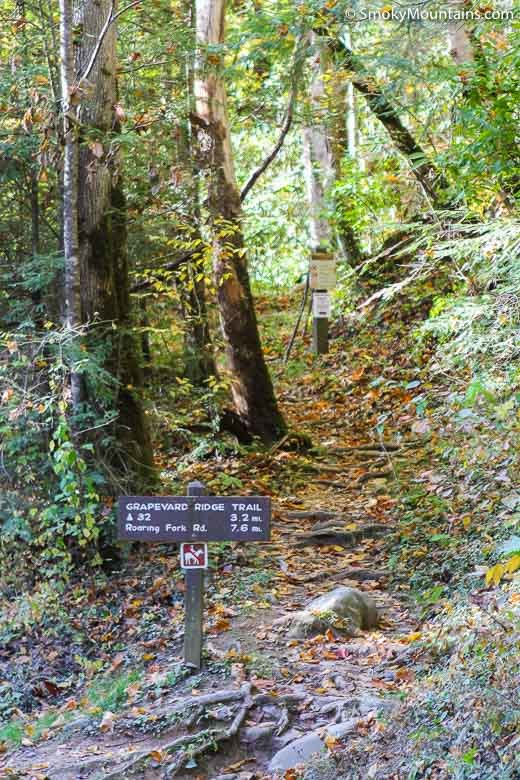


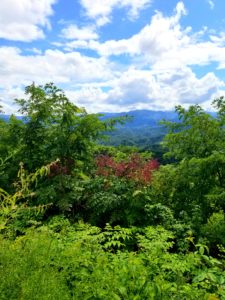
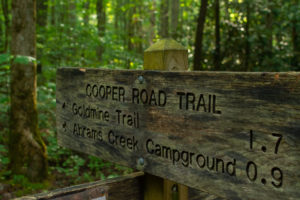
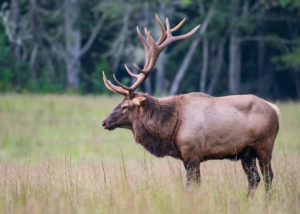

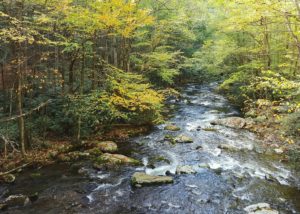

Gatlinburg Weather
Click for weather forecast